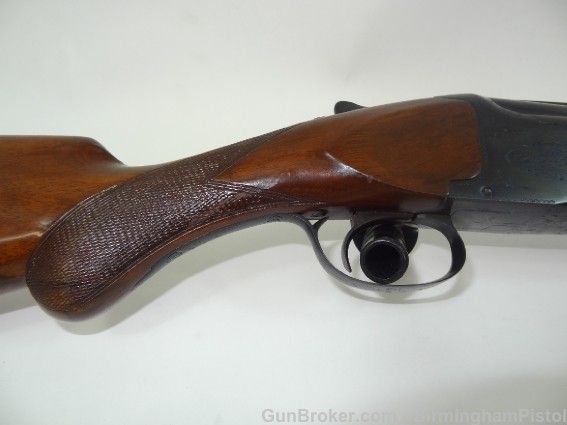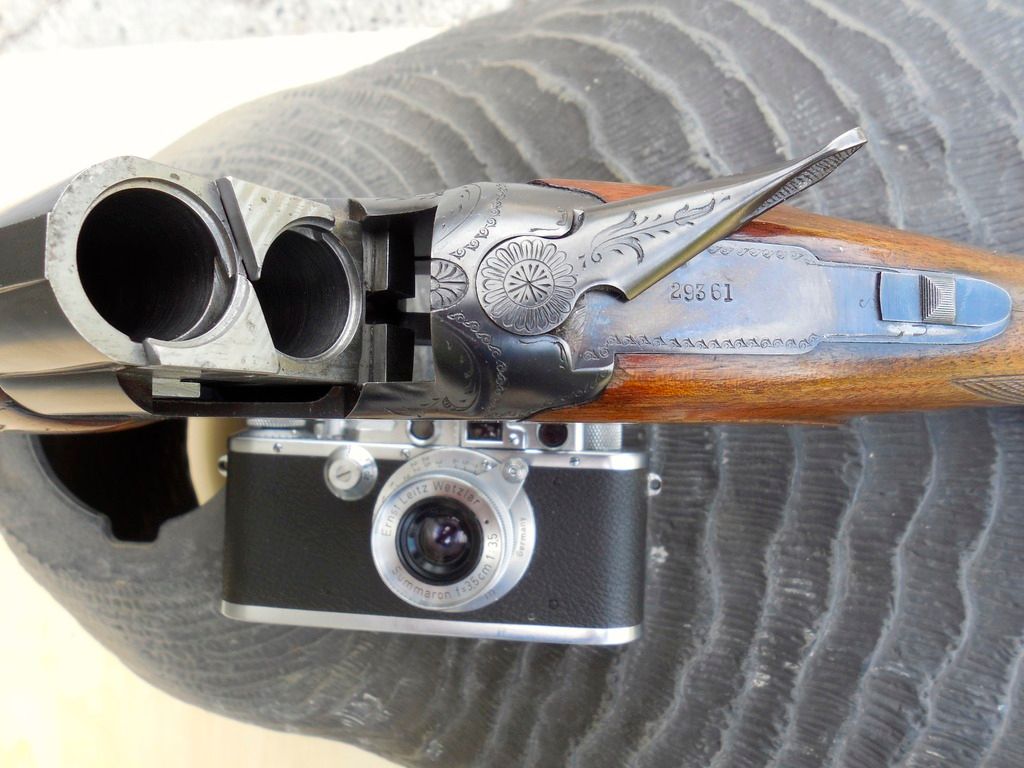The gun I seem to be missing is an over under.
I know that the pre war superposed's ended with serial number 17000, but I expect those to be a bit pricey.
What should I be looking for if I want the superposed equivalent of a pre-64 Winchester model 70.
I also need to know how to read the choke marks and whether a factory original would have had a recoil pad
Thank you in advance
Nothing so special about pre-war Superposed Brownings as opposed to later ones. Just avoid salt wood by sticking to round knob long tang guns...Geo
Bushmaster, you'll probably be pleasantly surprised. The 12-gauge Superposed may be one of the great bargains in the gun world - particularly if you're looking for a trap version. You want a long-tang version, no question, and in the trap version, I am partial to the Lightning Trap (has the round-knob stock and slim fore-end). Choke markings are based on asterisks and dashes. * = Full, *- = imp. Mod., ** = mod, **- = improved cylinder and **s = skeet. If you look around, you can probably find these between $1000 and $2500 as long as you're not looking at graded guns - and at the top of that scale, you should find a really nice example. The pre suffix guns (1962/3 and later) do seem to be bumping up again - used to be cheaper than a Citori with screw-ins).
Thank you
Pictures please of tang and knob
Did original guns come with butt plate or pad
Original guns could come either way, plate or pad. If the pad says Browning on its probably original. Round knob long tang:

Geo, did the factory ever use Pachmayr White Line pads to your knowledge or were they always just the ones marked Browning (and presumably made by Browning in-house)? I feel like I have seen a few so equipped and always assumed it to be aftermarket.
The browning marked pads were white-line pads made for browning by Pachmyer.
A pad would be standard on Magnum guns. A plate standard on 2-3/4" guns. Unless ordered with a pad.
In my experience, earlier guns (pre war) do not carry as much value as later guns (post war). The fit and finish was best in the late 1950s and early 1960s on these guns.
Bushmaster, sit up here on my knee and I will tell you about postwar Browning trap guns. I am working from memory and will edit. Immediately postwar, there were no trap guns, except 30" tight choked guns that were indistinguishable from field guns and had standard forends. A friend who tried to order a pair of Supers, one skeet, one trap, could not get Browning to make him a high stocked Trap gun with beavertail. This was probably just before 1950 (subject to revision). In the very early fifties (subject to change), there were 30" vent rib guns with beavertail forends, long tang, round knob, and horn buttplates, and 14 3/8" stocks with high dimensions. These are the rarest and most coveted guns, similar to Pre-64 Winchesters of the highest rarity. The next step is a recoil pad on the previous gun, probably about 1952 (subject to revision). This is not a bad gun, because it has the round knob, beavertail, and long tang, the last variation that shows these features. This is the rarest gun that a collector can realistically pursue. The next Trap variation, in my opinion, is the long tang, square knob variety, date unknown. The Broadway was introduced about 1961, with that same long tang, square knob variation, again subject to revision. Later variations are short tang, square knob, Broadway and Lightning rib. Good luck in your search for the holy grail of postwar Browning Traps, the long tang, round knob, hard horn buttplate, and beavertail forend. There aren't more than a handful of those guns that have not been fitted with a recoil pad. Find one in mint condition, and you have a real prize.
Geo, did the factory ever use Pachmayr White Line pads to your knowledge or were they always just the ones marked Browning (and presumably made by Browning in-house)? I feel like I have seen a few so equipped and always assumed it to be aftermarket.
What B.Dudley said far as i know...Geo
The Browning marked, White Line pads were not made in house. They were made by Pachmayr.
Deleted because of a sentence that did not make sense. Sorry.
Immediately postwar, there were no trap guns, except 30" tight choked guns that were indistinguishable from field guns and had standard forends.
With the resumption of Superposed production after WW-II the Trap Model was the 30" Standard weight 12-gauge gun and it had a stock a bit longer and 5/8 inch straighter then the stocks that came on the 26.5" Lightning Model and the 28" Field Model.

The early postwar 30" trap model that Reseacher points out would also be a real prize. It would be identical to the gun that came shortly after, except that Researcher's 30" gun would have a standard forend.
What you should know too is that those things have usually been shot loose and really were/are not up to volume shooting. The ejectors in particular are prone to wear to almost unusable states. I had a Broadway that was in fairly tight condition when I got it and even with the best of care I watched it wear out. Of course, I was shooting it not just SWIG'ing.
If you are interested in a QUALITY gun from that era you would prolly find considerably more happiness with a Beretta at any desired level/grade. Particularly if you plan to actually use the gun.
At a purely subjective level I always found any of the old Brownings to have a sorta klunky feel. And that deep slab sided action is just bordering, OK it's past, ugly compared to the Italian guns.
have another day
Dr.WtS
A couple of amendments. First, "trap" models started with the first 2000 postwar guns (serial over 17000). They differed from other supers in two ways. First, they had a straighter stock. Second, they had 30" barrels with ventilated ribs. Until the magnum model was introduced in about 1955, only the trap model had a 30" ventilated rib barrel. Field models could be had with 30" solid rib barrels. About 1953 the trap model added a larger "beavertail" fore end. That continued until about 1960 or 61 when the trap model only added a square knob (a year or two later it was added to skeet models). The BroadWay came out in 1962, and for the first time after WWII 32" barrels were available, but only on the BroadWay. Probably the best craftsmanship on Supers is on models from about 1954 to 1962. I would not worry a lot about a gun that is somewhat loose. It is about a $300 fix to weld and fit the locking lug. Usually needed somewhere between 50,000 and 100,000 rounds. I would worry about a loose rib. Many seperate, and it is a $700 fix to remove, resolder, and reblue the gun. Watch out for a used gun which someone has tried to reblue with superglue, exposy or by soldering without removing the entire rib.
Long range,
I love the Leica rangefinders, are they both 3F's?
I started out with my Grandfather's 3F, it is a beautifully made camera and it takes spectacular photos.
Dave, (Long Range), yours is one of the very scarce first variation postwar with field forend and hard butt. My favorite is the next variation with beavertail and hard butt. I bought my mint example from Smiling Gary S. at a York, PA show four or five years ago. I hadn't seen one in decades. I haven't seen one like Dave's since they were in production. Surviving hard butt traps are scarce, scarce, scarce.
Redoak: Yes the crome camera is a 111F Model Made in 1952. I keep a wide angle lens on this camera, the 3F did shoot the first two photos in my post.. The Black camera is a pre war 1938 model 2A Leica. I keep a post war F2 Summicron lens on this camera. This is the camera that shot the serial # photo. I sent them both to a man in New York 20 years ago for service, and they just keep on working. No problem to get film today, however Development is going the way of the buffalo. Nice lady in the local photo club develops and prints the film for me. She likes to smoke ducks and we sorta work on the barter system. That is what keeps me and the old leica's in operation. New modern photo stuff is much better but not as much fun.. I guess Old leica's are a lot like old double guns.. thanks for your comment. David




